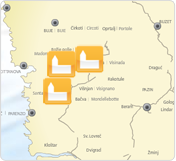
- Gradišće – Koper
- Podpeč – Zanigrad – Hrastovlje
- Slum – Roč – Hum
- Draguć – Paz – Gradinje – Gologorica
- Pićan – Gračišće – Lindar
- Pazin – Beram
- Oprtalj – Čirkoti – Rakotule
- Vižinada – Božje polje – Labinci
- Višnjan – Bačva – Poreč
- Sv. Lovreč – Kloštar
- Šorići – Dvigrad – Kanfanar
- Žminj – Svetvinčenat
- Bale – Batvači – Fažana – Pomer
- Bičići – Barban – Prodol
- Jasenovik – Nova Vas – Vranja
- Plomin – Brseč – Lovran
Vižinada – Božje polje – Labinci
Božje polje
Blessed Virgin Mary
The Church of the Blessed Virgin Mary in Božje polje is situated close to Vižinada, on the road to Poreč. This is where the important ancient road Via Flavia once passed. It was also the site of the monastery of the Knights Hospitaller, knightly order that provided care for the pilgrims on their way to the Holy Land. After leaving the monastery, they were replaced by the Franciscan Tertiaries, Glagolitic priests. They collected grapes and wine from peasants, a custom that still remains: during the grape harvest the priest of Vižinada rings the church bell in certain chapels and the locals bring him grapes. And as for wine, if you are passing through this area, you should definitely take on supplies from the local winemakers.
Although both the Franciscans and Knights Hospitaller were not commonplace in Istria, they left an indelible imprint on the history of Božje polje. In addition to the valuable church inventory, one of the mentioned imprints are the Late Gothic frescoes dating approximately from 1480. They were painted by the workshop of John from Kastav, and it seems that this is both its first and top quality work. The frescoes in the sanctuary have been preserved almost completely. On the northern wall are the virtually copied pages one and eight of the Biblia pauperum. These are the scenes of the Original Sin, Annunciation, Gideon's Fleece, David's Prayer and Joseph's Return from Egypt. The only exception from this iconographical pattern is the Coronation of the Virgin. The ceiling of the sanctuary depicts the iconography Symbolum apostolicum: in the central fields are zoomorphic symbols of the Four Evangelists holding scrolls containing the beginning of the corresponding Gospels in Latin. They are surrounded by eleven Apostles with scrolls of fragments of the Apostles' Creed. The Apostles are then surrounded by angels holding instruments or scrolls with fragments of the Glory. The most interesting instrument is the organistrum. This popular medieval instrument is a stringed instrument with keys that stopped the strings at different points, while the right hand, was used to turn a crank at the lower end of the body, rotating a wheel that rubbed against the strings to make them sound.
Behind the altar is the image of Christ seated on a throne as a ruler wearing a crown and holding an apple with cross, the symbol of royal authority. All these scenes are supplemented by numerous prophets and female saints in the window embrasures. On the southern wall of the nave is a preserved fresco, an imitation of an altar screen. In the middle is the image of the Virgin and Child surrounded by angels, and St. Peter and St. Paul standing on the side. Below this scene is a shallow niche depicting the Throne of Wisdom - with God the Father seated on a throne holding his Son, crucified Jesus Christ and between them the dove of the Holy Spirit.
The graphic models of this workshop are of Dutch origin. In addition to the already mentioned Biblia pauperum, graphic sheets of Israhel van Meckenem were used, immediately after they were made. Apart from these Late Gothic influences, there are also those reflecting the late soft style of South-Bohemian easel painting.
Imprimer la page Envoyer a un ami


















